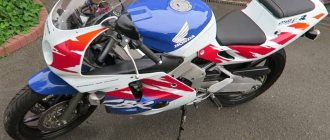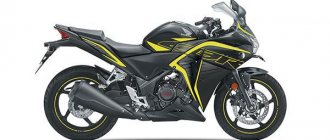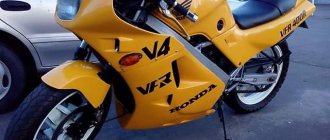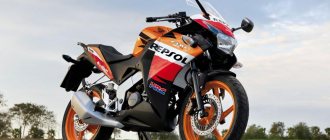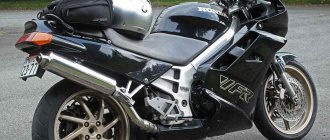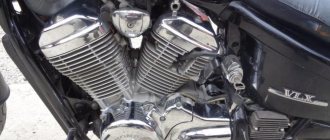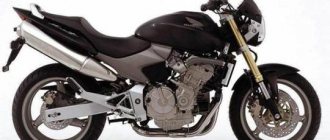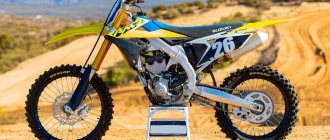Many believe that the Honda CR250R dates back to 1997. However, this is not entirely true. The first offer for sale of this motocross motorcycle dates back to 1973. After this there were a number of modifications, the most significant being the replacement of the material from which the frame was made.
The design of the first Honda CR250R models was based on a steel tubular frame.
In 1997, steel gave way to aluminum alloys and it was from this year that bikes appeared that became a true legend of motocross.
Features of Honda CR250R
Honda CR250R until 1997.
Honda CR250R since 1997.
The motorcycle has been in production for another 10 years, undergoing two restylings, a number of changes that radically affected its driving performance . The only major drawback that affected the entire further production of this model was the 2-stroke engine . At the beginning of the century, when all competitors had already acquired 4t, the CR250R looked somewhat strange. But this did not stop her from acquiring a huge army of fans around the world.
In 2007, the developers decide to end the production of 2-stroke bikes, concentrating on the production of new, more powerful models based on a modern engine and the CR250R, along with a number of other models, becomes history. Development of an alternative 4-stroke version began in 2003 . The new cross-country version was named Honda CRF250R .
Design
- Since 1997, the bike has received an aluminum frame. She could provide the ease necessary for speed. Thanks to careful calculations of the new geometry, good handling was achieved, and maneuverability was achieved through a dense arrangement of all parts.
The aluminum frame was modified twice - in 2000 and 2002. All changes were aimed at weight loss.
- An inverted fork was used to support the front wheel.. In 2002, she received a full range of settings and operating speed in 281 mm. The diameter of the feathers had a good margin for racing loads and amounted to 46 mm. The rear wheel uses a central shock absorber, which is mounted on a pendulum base. It also has all possible settings, and the spring stroke length was 219 mm.
Front fork.
Rear shock absorber.
- Other features of the bike included a minimum of electronics, a progressive carburetor and engine, increased ground clearance and convenience, as is typical for cross-country motorcycles.
Exterior
The appearance of the bike did not have any details by which it could be mistakenly attributed to other types. Models before 2002 had minimal body kit at all.
There was no plastic even where the gas tank is located on other models. The latest models began to look more standard, but this did not stop Honda from creating motorcycles whose reliability was unmatched.
Number plate.
Plastic cover.
Side view.
Front end
- A large wing raised as high as possible , a plate for the number and a handlebar with a wide grip - this is what the motorcycle looks like from the front. The bend of the latter gives good maneuverability, and at the same time allows the bike to be used by a pilot of any height.
- There are no bells and whistles typical for other types of motorcycles - everything is simple and functional .
Back view
Fuel tank.
Red seat.
Rear wing.
Black seat.
- The rear stem of the bike, like a regular motocross version, is sharp and “flying” . The sharp edges of the side plastic also create a flying impression. There is only one exhaust can, tucked right under the stem.
- The saddle is symbolic, designed for the athlete to ride standing on such a bike . However, in the model line there were options with a large thick “sofa” characteristic of the road version. This is what motorcycles produced before 2002 looked like. Then the saddle took on its usual appearance - a stripe on the frame.
- When examining the first releases of this model, users asked one question - where is its gas tank ? The complete absence of plastic showed that there was emptiness where you expected to see it. At the same time, the motorcycle, of course, has a tank - it’s just that due to the shortened saddle it is more pressed towards the user . The large lamb "lid" of the neck shows its position. Holds 7 liters of fuel.
Brief history of the model
- 1997 - the model receives an aluminum frame.
Model
: Honda CR250R (all markets).
Factory designation:
CR250RV.
- 1998 - no significant changes.
Model
: Honda CR250R (all markets).
Factory designation:
CR250RW.
- 1999 - The motorcycle is no longer equipped with the electronic Power Jet system.
Model
: Honda CR250R (all markets).
Factory designation:
CR250RX.
- 2000 - restyling of the model.
Model
: Honda CR250R (all markets).
Factory designation:
CR250RY.
- 2001 - no significant changes.
Model
: Honda CR250R (all markets).
Factory designation:
CR250R1.
- 2002 - restyling of the model.
Model
: Honda CR250R (all markets).
Factory designation:
CR250R2.
- 2003 - no significant changes.
Model
: Honda CR250R (all markets).
Factory designation:
CR250R3.
- 2004 - no significant changes.
Model
: Honda CR250R (all markets).
Factory designation:
CR250R4.
- 2005 - no significant changes.
Model
: Honda CR250R (all markets).
Factory designation:
CR250R5.
- 2006 - no significant changes.
Model
: Honda CR250R (all markets).
Factory designation:
CR250R6.
- 2007 is the last year of production.
Model
: Honda CR250R (all markets).
Factory designation:
CR250R7.
Specifications
With the exception of replacing the Keihin carburetor with the more progressive Mikuni Tm in 2002, the power plant has not undergone any significant changes during its evolution.
The single-cylinder engine has a liquid cooling system.
The bike had a 2-stroke, 1-cylinder engine.
- working volume - 249 cm3;
- power - 58 hp;
- number of valves - 8;
- cylinders - 2;
- cooling - liquid;
- fuel supply - carburetor (Keihin, since 2002 - Mikuni Tm) 38 mm;
- ignition - transistor (CDI);
- start - kick starter;
- fuel tank - 7.7 l.
Launching from the claw made it possible to remove the battery, which had a beneficial effect on maneuverability and speed.
Transmission and clutch
The bike had a 5-speed gearbox.
The rear swingarm is aluminum, the drive is classic chain – it couldn’t be any other way on cross-country.
- To fully exploit the capabilities, the gear ratios were selected in such a way that they covered the entire speed range , adjusting the speed accordingly.
- The pedal travel was reduced to the minimum acceptable, which had a beneficial effect on the dynamics.
- Multi-disc clutch, oil bath.
- The main drive is a chain.
Brakes
Front brake housing.
Rear disc brake.
Since 2002, the model began to change dramatically, losing interchangeability with earlier versions. Therefore, the redesigned brakes became unified .
The settings on both axles were the same, the force was transmitted hydraulically, and discs were used.
Front:
- number of disks - 1;
- diameter - 240 mm;
- support - 2-piston.
Rear:
- number of disks - 1;
- diameter - 240 mm;
- support - 1-piston.
Since the model is sports, no options were offered.
Engine
The CR 250 has a two-stroke engine with one cylinder. This engine is capable of producing very serious maximum performance: at 8000 rpm, the torque is 51 Nm, and the power at the same number of revolutions per minute reaches 58.2 hp. The maximum speed of the motorcycle is 150 km/h. The compression ratio is 8.7:1. The engine is liquid cooled and its working volume is 248 cm³. The motorcycle has a carburetor fuel supply system. Among the shortcomings of the motor, it is worth noting its sometimes excessive packaging density.
Dimensions and weight
The dry weight of the motorcycle does not exceed 97 kg . When filling with all necessary liquids - 110 kg .
Despite its narrow purpose, the dimensions of the bike are comparable to other road bikes.
- Length - 2,192 mm ;
- Width - 820 mm ;
- Height - 1,270 mm ;
- Wheelbase - 1,490 mm ;
- Ground clearance - 345 mm ;
- Seat height - 650 mm .
For whom is it intended?
Given the explosive nature of the bike, we can say that this 250 cc model is aimed at experienced riders.
Sport, like Enduro, by definition have a high seating position, but the CR250R had these parameters higher than most competitors.
With such a saddle height, a biker of either average or tall stature could control normally.
Ergonomics
With my height of 176 cm, both motorcycles suit me well, but the Honda seems to be tailor-made for my height. The Honda CRF250RX has the perfect riding position for me and there is no desire to move forward or backward. The Yamaha, even with the steering wheel in a position as close as possible to the seat, feels roomy; tall people will find it easier to adjust the ergonomics to suit themselves.
Both bikes feature four-way adjustable footpegs that allow riders to fine-tune a comfortable position. The distance between the footpegs and the seat of the RX and FX is almost identical - approximately 56 centimeters. The Honda's seat height is 1 centimeter lower than the Yamaha's 97 centimeters to the ground, but it feels even lower.
Yamaha YZ250FX 2019
Gas tanks vary in design and capacity. Honda uses a more conventional 8.5-liter design with developed radiator air intakes. This makes the bike feel a little heavy when fully loaded and a little wide. The FX's 7.6-liter fuel tank is located under the seat, resulting in smaller air intakes and more correct weight distribution. If you decide you need more fuel, larger third-party tanks are available for each model, with a capacity of just over 11 liters.
The seat style and shape are noticeably different between the two motorcycles. The Honda CRF250RX has a slightly more raked, seated position, while the Yamaha YZ250FX has a flatter, motocross-style seat. Both seats have specially padded tops for good grip in wet and dry conditions.
Honda CRF250RX 2019
Modifications
The model received 1 official modification, which became a “younger” sister.
Honda CR125R had all the parameters of the older one, with the exception of engine capacity, which was 124 cubic meters . It is interesting that the model did not receive the expected excitement among motorcycle schools. If they bought a “specialized sport”, they usually chose the 250 cc version.
The junior model CR125R in the Honda line was intended for beginners in trials and motocross.
Competitors
The following were able to provide healthy competition to this bike:
- Yamaha YZ250 - a motorcycle with an aluminum frame;
The following couple of Japanese developed their versions based on a steel frame:
- Kawasaki KX250 - half-duplex steel.
- Suzuki RM 250 - steel duplex.
The bikes were produced at approximately the same time, belonged to the same class, and did not differ significantly in design. The choice between them was mainly determined by buyer preferences.
Flaws
According to reviews from owners, the Honda CR250R is distinguished by good reliability, but requires timely maintenance, however, like all its classmates.
As always, there were some downsides. These include:
- Dense arrangement of parts ; during repairs you will have to disassemble the entire motorcycle:
- Lack of crankcase protection . When jumping, it is possible to break the lid with sharp stones.
- High fuel consumption and small tank.
But they also call it difficult to find and repair individual parts.
and dignity
Without differing in any technical features, this bike has all the qualities of a thoroughbred cross-country bike.
Of course there are more advantages:
- Reliability of both individual parts and the bike as a whole.
- Adjustable suspension.
- Unpretentious in maintenance.
- A rarity for crossbreeds is a comfortable, ergonomic fit .
- Ease of operation.
They also note maneuverability, the ability to jump onto the highest curb and even slide down the stairs.
Reviews
Reviews of Honda CR250R:
Expand Collapse
2004 Cheerful foxpet. I skated the first stage on it in Vladikavkaz in the mountains and on Buinykh in Kaluga. Now I'm going to Iron Man. Easy to maintain and relatively cheaper than 4t. And the main engine starts upside down, though... from the foot, and not from the button.
There are no headlights and no title... Read, buy him a car and a trailer)) But now he has something to race with.
By the way, I have a bulldozer on the exhaust that, at low speeds, blocks the exhaust and the bottoms (if we can even talk about the bottom on a cross bike) are fine there. I changed the bearings in the rocking chair using screws - 7 identical Russian ones. It worked out in 360re. Pleased. But all the same, this is a cross - light, powerful, with an upright suspension, a rigid frame - it jumps and goes straight. The air filter can, after the dowel, was disappointing - it’s not there, you can’t dive into the water up to the tank.
In Vladik I threw out almost all the antifreeze, only 350 grams left, because... There is no expansion tank on it. A friend recently bought a CR250R 2003, naturally, on the very first ride I tested it... In comparison with the CRF450X, I only felt less weight, but I didn’t find the promised 58 horses!? Moreover, I turned the engine this way and that, but the feeling seemed to me weaker than the CRF450X, maybe something was not tuned up, the muffler is cutting, the engine seems to have been serviced, but it is clear that it is far from the first freshness. But thanks to the weight, it brakes noticeably better with absolutely identical brakes. But the clutch is tighter; out of habit, your hand quickly gets tired of squeezing it, considering that on the 2T you need to play with the clutch more often, this is a big minus. The maximum speed in a straight line is no more than 80-90 km/h. In general, for some reason I’ve changed my mind about buying a CR250R... And my friend is happy, having switched to it from an XR650R!
